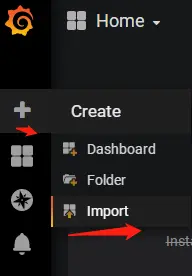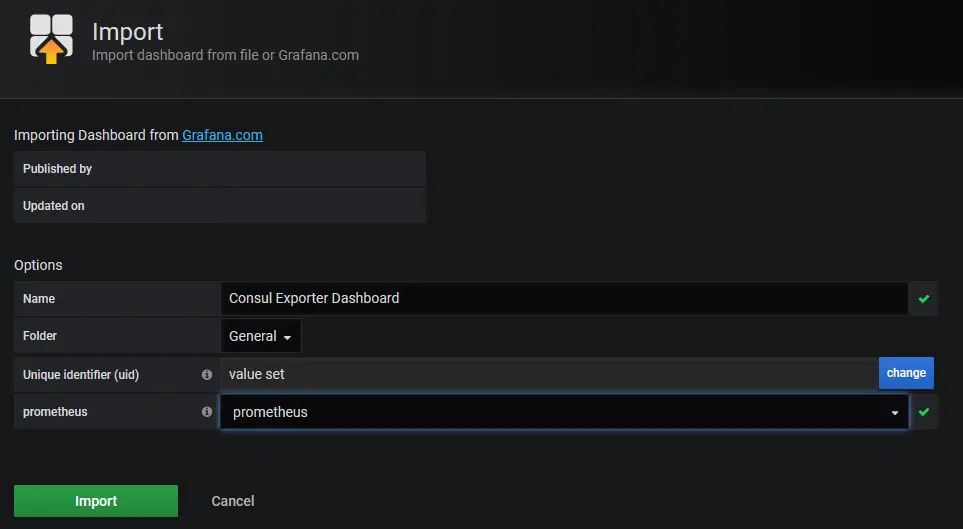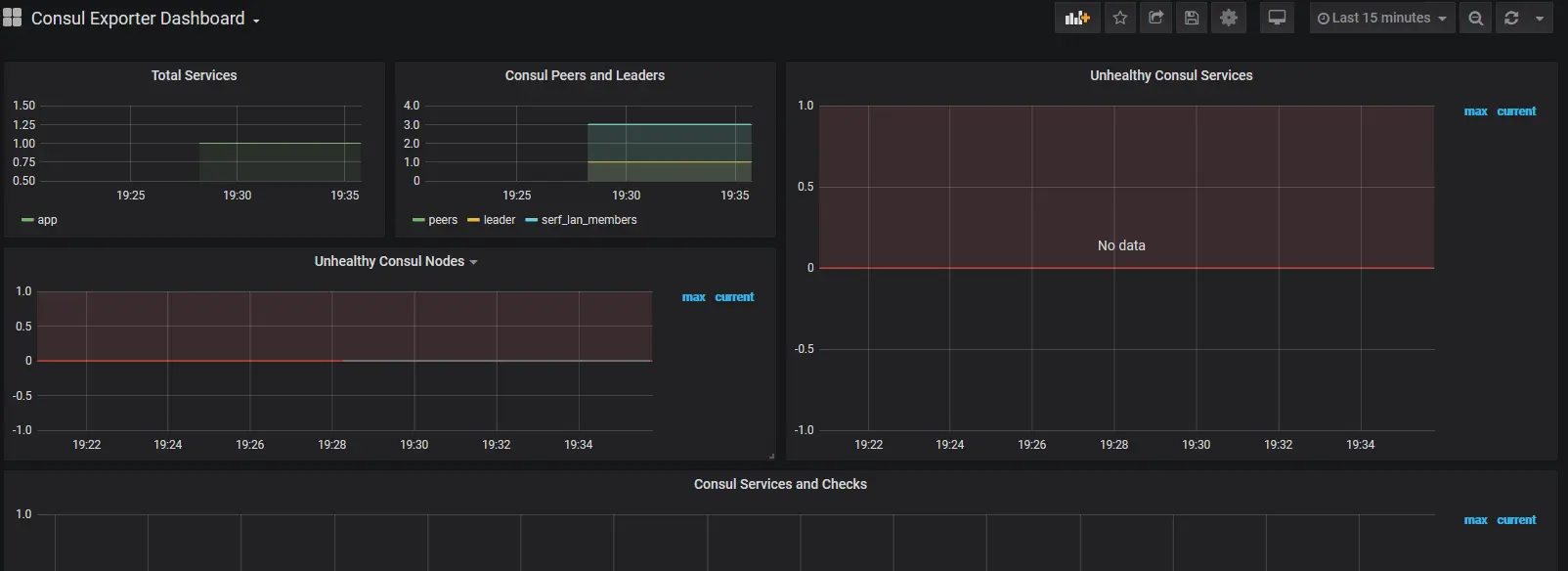consul简介
Consul是一个服务网格(微服务间的 TCP/IP,负责服务之间的网络调用、限流、熔断和监控)解决方案,它是一个一个分布式的,高度可用的系统,而且开发使用都很简便。它提供了一个功能齐全的控制平面,主要特点是:服务发现、健康检查、键值存储、安全服务通信、多数据中心。
安装准备
- 树莓派k8s集群
root@pi4-master01:~# kubectl get nodes -o wide
NAME STATUS ROLES AGE VERSION INTERNAL-IP EXTERNAL-IP OS-IMAGE KERNEL-VERSION CONTAINER-RUNTIME
pi4-master01 Ready master 4d18h v1.15.10 192.168.5.18 <none> Ubuntu 20.04 LTS 5.4.0-1011-raspi docker://18.9.9
pi4-node01 Ready node 4d17h v1.15.10 192.168.5.19 <none> Ubuntu 20.04 LTS 5.4.0-1011-raspi docker://18.9.9
pi4-node02 Ready node 4d17h v1.15.10 192.168.5.20 <none> Ubuntu 20.04 LTS 5.4.0-1011-raspi docker://18.9.9
- 树莓派k8s集群已安装helm
root@pi4-master01:~/k8s/cluster-monitoring-0.37.0# helm version
Client: &version.Version{SemVer:"v2.15.0", GitCommit:"c2440264ca6c078a06e088a838b0476d2fc14750", GitTreeState:"clean"}
Server: &version.Version{SemVer:"v2.15.0+unreleased", GitCommit:"9668ad4d90c5e95bd520e58e7387607be6b63bb6", GitTreeState:"dirty"}
- 树莓派k8s集群已安装存储类,并设置为默认存储
root@pi4-master01:~/k8s/cluster-monitoring-0.37.0# kubectl get storageclass
NAME PROVISIONER AGE
local-path (default) rancher.io/local-path 4d15h
对了,如果你还没有树莓派k8s集群,这里有一篇树莓派 k8s 集群入坑指南可以参考,欢迎入坑。
helm安装consul集群
这里我们选择用helm安装,helm有一个默认仓库stable,指向https://kubernetes-charts.storage.googleapis.com, 国内访问比较困难,所以网上很多安装helm的文档都以https://kubernetes.oss-cn-hangzhou.aliyuncs.com/charts 来代替。但最近发现,这个仓库也不再更新了,很多chart的最新版本都没有,这里提供一个新地址http://mirror.azure.cn/kubernetes/charts 。经简单验证,发现这个仓库至少比阿里的那个仓库新,建议切换。
root@pi4-master01:~# helm repo remove stable
"stable" has been removed from your repositories
root@pi4-master01:~# helm repo add stable http://mirror.azure.cn/kubernetes/charts/
"stable" has been added to your repositories
root@pi4-master01:~# helm repo list
NAME URL
local http://127.0.0.1:8879/charts
stable http://mirror.azure.cn/kubernetes/charts/
root@k8s-master:~# helm search consul
NAME CHART VERSION APP VERSION DESCRIPTION
NAME CHART VERSION APP VERSION DESCRIPTION
stable/consul 3.9.6 1.5.3 Highly available and distributed service discovery and ke...
stable/prometheus-consul-exporter 0.1.5 0.4.0 A Helm chart for the Prometheus Consul Exporter
stable/consul就是我们需要安装的chart。
- 使用helm安装consul集群命令如下
helm install -n consul \
stable/consul \
--set image=arm64v8/consul
通过上述命令,将以默认的配置在Kubernetes中部署consul集群。默认情况下,chart会安装部署3个consul节点。
该chart中涉及的consul镜像是x86的,只要把镜像换成arm64v8架构的镜像即可。另外,该chart默认开启了持久化存储,不指定storageclass的话,将使用k8s的默认存储。因为我们的树莓派k8s集群已经设置了local-path为默认storageclass,所以不需要关闭持久化存储既可正常安装。
- 查看创建的pod
root@pi4-master01:~# kubectl get po|grep consul
consul-0 1/1 Running 0 6m30s
consul-1 1/1 Running 0 5m28s
consul-2 1/1 Running 0 4m36s
- 查看创建的svc
root@pi4-master01:~# kubectl get svc|grep consul
consul ClusterIP None <none> 8500/TCP,8400/TCP,8301/TCP,8301/UDP,8302/TCP,8302/UDP,8300/TCP,8600/TCP,8600/UDP 6m58s
consul-ui NodePort 10.96.189.212 <none> 8500:5514/TCP 6m58s
- 查看创建的pv,pvc
root@pi4-master01:~# kubectl get svc|grep consul
consul ClusterIP None <none> 8500/TCP,8400/TCP,8301/TCP,8301/UDP,8302/TCP,8302/UDP,8300/TCP,8600/TCP,8600/UDP 6m58s
consul-ui NodePort 10.96.189.212 <none> 8500:5514/TCP 6m58s
root@pi4-master01:/home/charts/stable# kubectl get pvc,pv|grep consul
persistentvolumeclaim/datadir-consul-0 Bound pvc-5152f066-7500-40ed-b008-a2c037b499bf 1Gi RWO local-path 7m37s
persistentvolumeclaim/datadir-consul-1 Bound pvc-176f02f6-3e5d-4cf2-a506-0348b397e33c 1Gi RWO local-path 6m35s
persistentvolumeclaim/datadir-consul-2 Bound pvc-b7dd4760-caf7-43f7-82ae-1dcf36e0618c 1Gi RWO local-path 5m43s
persistentvolume/pvc-176f02f6-3e5d-4cf2-a506-0348b397e33c 1Gi RWO Delete Bound default/datadir-consul-1 local-path 6m31s
persistentvolume/pvc-5152f066-7500-40ed-b008-a2c037b499bf 1Gi RWO Delete Bound default/datadir-consul-0 local-path 7m34s
persistentvolume/pvc-b7dd4760-caf7-43f7-82ae-1dcf36e0618c 1Gi RWO Delete Bound default/datadir-consul-2 local-path 5m40s
验证
访问http://192.168.5.18:5514/ui/dc1/services ,页面显示如下

该chart默认使用的consul镜像是consul:v1.5.3。
- 查看当前consul版本
root@pi4-master01:~# kubectl exec consul-0 -- sh -c 'consul version'
Consul v1.5.3
Protocol 2 spoken by default, understands 2 to 3 (agent will automatically use protocol >2 when speaking to compatible agents)
可以看到对应consul的版本是v1.5.3。
- 查看consul集群信息
root@pi4-master01:~# kubectl exec consul-0 -- sh -c 'consul members'
Node Address Status Type Build Protocol DC Segment
consul-0 10.244.0.184:8301 alive server 1.5.3 2 dc1 <all>
consul-1 10.244.2.110:8301 alive server 1.5.3 2 dc1 <all>
consul-2 10.244.1.107:8301 alive server 1.5.3 2 dc1 <all>
- 动态伸缩能力验证
默认安装是3个节点
root@pi4-master01:~# kubectl get po|grep consul
consul-0 1/1 Running 0 36m
consul-1 1/1 Running 0 35m
consul-2 1/1 Running 0 35m
将consul水平扩容为5个节点
root@pi4-master01:~# kubectl patch statefulset/consul -p '{"spec":{"replicas": 5}}'
statefulset.apps/consul patched
root@pi4-master01:~# kubectl get po|grep consul
consul-0 1/1 Running 0 38m
consul-1 1/1 Running 0 37m
consul-2 1/1 Running 0 36m
consul-3 1/1 Running 0 6m27s
consul-4 1/1 Running 0 6m4s
将consul水平缩容为3个节点
root@pi4-master01:~# kubectl patch statefulset/consul -p '{"spec":{"replicas": 3}}'
statefulset.apps/consul patched
root@pi4-master01:~# kubectl get po|grep consul
consul-0 1/1 Running 0 38m
consul-1 1/1 Running 0 37m
consul-2 1/1 Running 0 36m
其它配置
基于helm在树莓派k8s集群安装consul集群还是很方便的,只需要使用arm64v8架构的镜像即可。但是如果想要部署的consul集群更具有个性,还是很有必要研究一下该chart的其它配置项,这些配置项我们可以通过helm inspect命令来查看
root@pi4-master01:~# helm inspect values stable/consul
# Default values for consul.
# This is a YAML-formatted file.
# Declare name/value pairs to be passed into your templates.
# name: value
## Consul service ports
HttpPort: 8500
RpcPort: 8400
SerflanPort: 8301
SerflanUdpPort: 8301
SerfwanPort: 8302
SerfwanUdpPort: 8302
ServerPort: 8300
ConsulDnsPort: 8600
## Specify the domain with which consul should run with
## This will be passed as a -domain parameter
Domain: consul
## Used as selector
Component: "consul"
Replicas: 3
Image: "consul"
ImageTag: "1.5.3"
ImagePullPolicy: "Always"
Resources: {}
# requests:
# cpu: "100m"
# memory: "256Mi"
# limits:
# cpu: "500m"
# memory: "512Mi"
## Persistent volume size
priorityClassName: ""
Storage: "1Gi"
## Needed for 0.8.0 and later IF all consul containers are spun up
## on the same machine. Without this they all generate the same
## host id.
DisableHostNodeId: false
## Datacenter name for consul. If not supplied, will use the consul
## default 'dc1'
# DatacenterName: dc1
## Explicitly set LAN hosts to join.
# Added as -retry-join argument
# If you set joinPeers then we will not auto-build the list of peers for you
# These hostnames will be verified to be resolvable and ping-able before the consul service will start
joinPeers: []
## Set list of WAN hosts to join
# Added as -retry-join-wan argument
# These hostnames will be verified to be resolvable before the consul service will start
joinWan: []
## Encrypt Gossip Traffic
Gossip:
Encrypt: true
Create: true
## predefined value for gossip key.
## Will use a generated random alpha numeric if not provided
# GossipKey: key
## consul data Persistent Volume Storage Class
## If defined, StorageClassName: <storageClass>
## If set to "-", StorageClassName: "", which disables dynamic provisioning
## If undefined (the default) or set to null, no storageClassName spec is
## set, choosing the default provisioner. (gp2 on AWS, standard on
## GKE, AWS & OpenStack)
##
# StorageClass: "-"
## Setting maxUnavailable will create a pod disruption budget that will prevent
## voluntarty cluster administration from taking down too many consul pods. If
## you set maxUnavailable, you should set it to ceil((n/2) - 1), where
## n = Replicas. For example, if you have 5 or 6 Replicas, you'll want to set
## maxUnavailable = 2. If you are using the default of 3 Replicas, you'll want
## to set maxUnavailable to 1.
maxUnavailable: 1
## nodeAffinity settings
# nodeAffinity:
# requiredDuringSchedulingIgnoredDuringExecution:
# nodeSelectorTerms:
# - matchExpressions:
# - key: cloud.google.com/gke-preemptible
# operator: NotIn
# values:
# - true
## Affinity settings
affinity: |
podAntiAffinity:
preferredDuringSchedulingIgnoredDuringExecution:
- weight: 1
podAffinityTerm:
topologyKey: kubernetes.io/hostname
labelSelector:
matchExpressions:
- key: component
operator: In
values:
- "{{ .Release.Name }}-{{ .Values.Component }}"
## Enable Consul Web UI
##
ui:
enabled: true
## Create dedicated UI service
##
uiService:
enabled: true
type: "NodePort"
annotations: {}
ConsulConfig: []
# - type: secret
# name: consul-defaults
# - type: configMap
# name: consul-defaults
## Create an Ingress for the Web UI
uiIngress:
enabled: false
annotations: {}
labels: {}
hosts: []
path: /
tls: []
## Useful when ACLs are enabled
acl:
enabled: false
masterToken: ""
agentToken: ""
## test container details
test:
image: lachlanevenson/k8s-kubectl
imageTag: v1.4.8-bash
rbac:
create: false
serviceAccountName: ""
nodeSelector: {}
tolerations: []
additionalLabels: {}
podAnnotations: {}
# Lifecycle for StatefulSet
# lifecycle:
# preStop:
# exec:
# command:
# - sh
# - -c
# - "sleep 60"
forceIpv6: false
显然,配置项很丰富,从端口配置、是否开启ingress都能支持。
安装监控
安装监控前,需要在集群部署prometheus,否则不会有效果。可以参考树莓派k8s集群安装监控prometheus进行部署。
consul的监控需要单独安装,这里我们选择https://github.com/pi4k8s/pi4charts/tree/master/monitor/charts/consul-monitor 进行安装,该仓库内置的镜像是prom/consul-exporter:latest,该镜像支持多架构,可以同时支持arm64v8和x86。
使用helm安装开consul监控命令如下
root@pi4-master01:~# git clone https://github.com/pi4k8s/pi4charts.git
root@pi4-master01:~# cd pi4charts
root@pi4-master01:~/pi4charts# helm install -n consul-monitor \
monitor/charts/consul-monitor/ \
--set consulServer=consul:8500
确认安装状态
root@pi4-master01:~# kubectl get pod | grep consul
consul-0 1/1 Running 0 3h48m
consul-1 1/1 Running 0 3h47m
consul-2 1/1 Running 0 3h46m
consul-monitor-f68cdb4d-w72zq 1/1 Running 0 68s
root@pi4-master01:~# kubectl get svc | grep consul
consul ClusterIP None <none> 8500/TCP,8400/TCP,8301/TCP,8301/UDP,8302/TCP,8302/UDP,8300/TCP,8600/TCP,8600/UDP 3h48m
consul-monitor ClusterIP 10.111.89.48 <none> 9107/TCP 112s
consul-ui NodePort 10.96.189.212 <none> 8500:5514/TCP 3h48m
root@pi4-master01:~# kubectl get servicemonitor --all-namespaces |grep consul
default consul-monitor 2m42s
在prometheus查看exporter是否生效

生效后在grafana系统配置consul监控面板
- consul监控面板 :https://grafana.com/grafana/dashboards/12049
部署步骤如下:


点"Upload .json file"按钮,选择已经下载好的consul监控面板文件 ,进入面板设置界面如下

设置好相应参数后,点"Import"按钮,继续导入,引导入consul监控页面如下

总结
本实践简单介绍了如何使用chart在树莓派k8s集群用helm部署consul和consul-monitor,读者可以基于自己的需要自行调整consul参数以便适用更多场景。
参考:






评论区